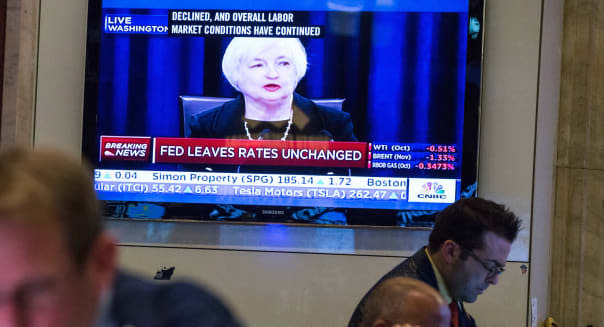Strategies for Stock Investors After Fed Holds Rates Steady

By Kira Brecht
Unless you've had your head under a rock, you probably heard the Federal Reserve didn't change its interest rate policy at its meeting last week. Now that the dust has settled and the TV talking heads have quieted down, let's take a look at what the still ultra low interest rate environment could mean for stock investors.
The bull market in stocks is not over. The current rising trend in U.S. stocks began at the March 2009 low in the Standard & Poor's 500 index. While concerns about a slowdown in Chinese economic growth and what that could mean for the U.S. economy have triggered significant volatility in U.S. equity markets in recent weeks, the stock market bull is not dead yet, analysts say.
Even when the Federal Reserve does finally increase the federal funds rate from its ultralow zero to 0.25 percent, where it has been stuck since December 2008, the end of the rising equity trend will not be at hand. "There have been nine rate hike cycles since 1950. In eight of the nine cycles, stocks are up an average of 10 percent in the year after the first rate hike," says John Canally, vice president and economist at LPL Financial, a Boston-based broker-dealer.
%VIRTUAL-pullquote-The first Fed rate hike is not the end of the bull market and it's not the end of the expansion.%Economists now point to the Federal Reserve's October or December meetings as the next likely time for a potential rate hike, but Canally downplays the overall impact for the stock market. "The first Fed rate hike is not the end of the bull market and it's not the end of the expansion."
High-yield dividend stocks remain attractive. With interest rates remaining at historically low levels, fixed-income investors don't get paid much to save in traditional certificates of deposit or even in T-bills, notes or bonds. "The zero interest-rate policy is killing seniors, savers and retirees," says Chris Bertelsen, chief investment officer at Global Financial Private Capital, a Sarasota, Florida-based wealth management firm.
He points to the beaten-down energy stock sector as a potentially attractive area of the market to consider, especially with the Fed holding down interest rates for now. "The large oil companies like ConocoPhillips (COP), ExxonMobil (XOM) and Chevron (CVX) are attractive because of their yields," Bertelsen says. "I wouldn't be afraid to look for something with a little higher yield, like Duke Energy (DUK) or Southern Co. (SO), because the Fed is still on hold."
Consider international exposure. At its latest policy-making meeting last week, the Fed downgraded a bevy of its forecasts, which included lower interest rates, lower inflation and even lower overall economic growth. The central bank projected that the U.S. economy will expand by 1.8 to 2.2 percent over the long run, versus previous growth forecasts of 2 to 2.3 percent.
While economists have worried of late about a slowdown in China, overall economic growth there is still strong compared with the U.S.
Credit Suisse (CS) forecasts U.S. GDP growth at a 2.6 percent pace in 2015, versus a 6.8 percent in China and 8.1 percent in India. "Long-term investors looking five to 10 years out may want to start adding emerging market exposure. Their economies will still grow three times faster than our economy over the next five years," Canally says.
Be selective. It's a stock picker's market now. The current environment, ripe with uncertainty over the timing of the first interest rate hike and the state of the Chinese economy, means this "is going to be a stock picker's market. If you are a long-term investor, there are opportunities to be selective in the right places," says Jeff Carbone, senior partner at Cornerstone Financial Partners, a wealth management firm in Charlotte, North Carolina.
Eye on the Upside
Carbone points to the recent correction in stock prices as an "opportunity to average in and buy at a lower point." He highlights the consumer discretionary, technology and health care sectors as areas that "should give you upside" in the current environment.
The consumer discretionary sector includes companies that sell nonessential services, such as automotive, restaurants, hotels, leisure equipment and consumer retailing services.
"The lower oil prices can help the consumer discretionary sector," says Bill Northey, chief investment officer at U.S. Bank's Private Client Group in Minneapolis. More cash in consumers' pockets means they could be spending more on items they normally wouldn't.
Northey also is favorably disposed to the technology sector, as it "still represents opportunity for material earnings gains," he says. The health care sector has benefited from a wider demographic base in the wake of the Affordable Care Act, as more insured means increased demand as more people have access to health care.
While the Fed failed to deliver any blockbuster news, investors can now refocus on the true fundamentals of the market. "Get back to assessing company earnings," Northey says. Third-quarter earnings results will start hitting the market by the end of September. He still expects stocks to end the year higher than current levels, with a 2,100 year-end target for the S&P 500 (^GSPC).
